A Novel Branched Al2O3/Silicon Rubber Composite with Improved Thermal Conductivity and Excellent Electrical Insulation Performance
Abstract
:1. Introduction
2. Materials and Methods
2.1. Materials
2.2. Preparation of B-Al2O3/SR Composites
2.3. Characterization
3. Results and Discussion
3.1. Characterizations of B-Al2O3 Particles
3.2. Microstructure of B-Al2O3/SR Composites
3.3. Thermal Conductive Property of B-Al2O3/SR Composites
3.4. Thermal Stability of B-Al2O3/SR Composites
3.5. Electrical Properties of B-Al2O3/SR Composites
3.6. Tensile Properties of B-Al2O3/SR Composites
4. Conclusions
Author Contributions
Funding
Data Availability Statement
Conflicts of Interest
References
- Xu, X.; Chen, J.; Zhou, J.; Li, B. Thermal conductivity of polymers and their nanocomposites. Adv. Mater. 2018, 30, e1705544. [Google Scholar] [CrossRef] [Green Version]
- Mani, D.; Vu, M.C.; Jeong, T.-H.; Kim, J.-B.; Lim, C.-S.; Lim, J.-H.; Kim, K.-M.; Kim, S.-R. 3D structured graphene fluoride-based epoxy composites with high thermal conductivity and electrical insulation. Compos. Part A Appl. Sci. Manuf. 2021, 149, 106585. [Google Scholar] [CrossRef]
- Su, Y.; Ma, Q.; Liang, T.; Yao, Y.; Jiao, Z.; Han, M.; Pang, Y.; Ren, L.; Zeng, X.; Xu, J.; et al. Optimization of effective thermal conductivity of thermal interface materials based on the genetic algorithm-driven random thermal network model. ACS Appl. Mater. Interfaces 2021, 13, 45050–45058. [Google Scholar] [CrossRef]
- Zhang, X.; Dong, J.; Pan, D.; Yang, G.; Su, F.; Ji, Y.; Liu, C.; Shen, C. Constructing dual thermal conductive networks in electrospun polyimide membranes with highly thermally conductivity but electrical insulation properties. Adv. Compos. Hybrid Mater. 2021. [Google Scholar] [CrossRef]
- Yu, L.; Gao, S.; Yang, D.; Wei, Q.; Zhang, L. Improved Thermal conductivity of polymer composites by noncovalent modification of boron nitride via tannic acid chemistry. Ind. Eng. Chem. Res. 2021, 60, 12570–12578. [Google Scholar] [CrossRef]
- Hu, J.; Huang, Y.; Yao, Y.; Pan, G.; Sun, J.; Zeng, X.; Sun, R.; Xu, J.; Song, B.; Wong, C.-P. Polymer composite with improved thermal conductivity by constructing a hierarchically ordered three-dimensional interconnected network of BN. ACS Appl. Mater. Interfaces 2017, 9, 13544–13553. [Google Scholar] [CrossRef] [PubMed]
- Ma, H.; Gao, B.; Wang, M.; Yuan, Z.; Shen, J.; Zhao, J.; Feng, Y. Strategies for enhancing thermal conductivity of polymer-based thermal interface materials: A review. J. Mater. Sci. 2021, 56, 1064–1086. [Google Scholar] [CrossRef]
- Guo, Y.; Ruan, K.; Shi, X.; Yang, X.; Gu, J. Factors affecting thermal conductivities of the polymers and polymer composites: A review. Compos. Sci. Technol. 2020, 193, 108134. [Google Scholar] [CrossRef]
- Huang, X.; Zhi, C.; Lin, Y.; Bao, H.; Wu, G.; Jiang, P.; Mai, Y.-W. Thermal conductivity of graphene-based polymer nanocomposites. Mater. Sci. Eng. R. Rep. 2020, 142, 100577. [Google Scholar] [CrossRef]
- Meng, X.; Yu, H.; Wang, L.; Wu, X.; Amin, B.U. Recent Progress on fabrication and performance of polymer composites with highly thermal conductivity. Macromol. Mater. Eng. 2021, 2100434. [Google Scholar] [CrossRef]
- Zhang, H.; Shi, T.; Ma, A. Recent Advances in design and preparation of polymer-based thermal management material. Polymers 2021, 13, 2797. [Google Scholar] [CrossRef] [PubMed]
- Yang, D.; Huang, S.; Ruan, M.; Li, S.; Yang, J.; Wu, Y.B.; Guo, W.; Zhang, L. Mussel inspired modification for aluminum oxide/silicone elastomer composites with largely improved thermal conductivity and low dielectric constant. Ind. Eng. Chem. Res. 2018, 57, 3255–3262. [Google Scholar] [CrossRef] [Green Version]
- Ruan, M.; Yang, D.; Guo, W.; Zhang, L.; Li, S.; Shang, Y.; Wu, Y.; Zhang, M.; Wang, H. Improved dielectric properties, mechanical properties, and thermal conductivity properties of polymer composites via controlling interfacial compatibility with bio-inspired method. Appl. Surf. Sci. 2018, 439, 186–195. [Google Scholar] [CrossRef]
- Yao, Y.; Zeng, X.; Guo, K.; Sun, R.; Xu, J. The effect of interfacial state on the thermal conductivity of functionalized Al2O3 filled glass fibers reinforced polymer composites. Compos. Part A Appl. Sci. Manuf. 2015, 69, 49–55. [Google Scholar] [CrossRef]
- Pan, Z.; Liu, Y.; Wang, F.; Lu, G.; Yang, F.; Cheng, F. Al2O3 Dispersion-Induced micropapillae in an epoxy composite coating and implications in thermal conductivity. ACS Omega 2021, 6, 17870–17879. [Google Scholar] [CrossRef]
- Jeong, U.S.; Lee, Y.J.; Shin, D.G.; Lim, H.M.; Mun, S.Y.; Kwon, W.T.; Kim, S.R.; Kim, Y.H.; Shim, K.B. Highly thermal conductive alumina plate/epoxy composite for electronic packaging. Trans. Electr. Electron. Mater. 2015, 16, 351–354. [Google Scholar] [CrossRef] [Green Version]
- Burger, N.; Laachachi, A.; Ferriol, M.; Lutz, M.; Toniazzo, V.; Ruch, D. Review of thermal conductivity in composites: Mechanisms, parameters and theory. Prog. Polym. Sci. 2016, 61, 1–28. [Google Scholar] [CrossRef]
- Song, J.; Peng, Z.; Zhang, Y. Enhancement of thermal conductivity and mechanical properties of silicone rubber composites by using acrylate grafted siloxane copolymers. Chem. Eng. J. 2020, 391, 123476. [Google Scholar] [CrossRef]
- Kargar, F.; Barani, Z.; Salgado, R.A.; Debnath, B.; Lewis, J.S.; Aytan, E.; Lake, R.K.; Balandin, A.A. Thermal percolation threshold and thermal properties of composites with high loading of graphene and boron nitride fillers. ACS Appl. Mater. Interfaces 2018, 10, 37555–37565. [Google Scholar] [CrossRef]
- Huang, H.; Yan, L.; Guo, Y.; Lin, H.L.; Chen, L.; Yang, L.F.; Xie, Y.J.; Bian, J. Morphological, mechanical and thermal properties of PA6 nanocomposites Co-Incorporated with Nano-Al2O3 and graphene oxide fillers. Polymers 2020, 188, 122119. [Google Scholar] [CrossRef]
- Lule, Z.; Yang, J.; Kim, J. A Study on the thermal conductivity of poly (lactic acid)/alumina composites: The effect of the filler treatment. J. Nanosci. Nanotechnol. 2020, 20, 229–238. [Google Scholar] [CrossRef]
- Wondu, E.; Lule, Z.; Kim, J. Thermal conductivity and mechanical properties of thermoplastic polyurethane-/silane-modified AL2O3 composite fabricated via melt compounding. Polymers 2019, 11, 1103. [Google Scholar] [CrossRef] [PubMed] [Green Version]
- Wu, S.; Xiong, Q.; Li, X.; Chen, D.; Liu, B. Properties of thermally conductive silicone rubbers filled with admicellar polymerized polypyrrole-coated Al2O3 particles. J. Appl. Polym. Sci. 2021, 138, 50205. [Google Scholar] [CrossRef]
- Zou, D.; Huang, X.; Zhu, Y.; Chen, J.; Jiang, P. Boron nitride nanosheets endow the traditional dielectric polymer composites with advanced thermal management capability. Compos. Sci. Technol. 2019, 177, 88–95. [Google Scholar] [CrossRef]
- Bian, W.; Yao, T.; Chen, M.; Zhang, C.; Shao, T.; Yang, Y. The synergistic effects of the micro-BN and nano-Al2O3 in micro-nano composites on enhancing the thermal conductivity for insulating epoxy resin. Compos. Sci. Technol. 2018, 168, 420–428. [Google Scholar] [CrossRef]
- Ren, L.; Zeng, X.; Zhang, X.; Sun, R.; Tian, X.; Zeng, Y.; Xu, J.; Wong, C.-P. Silver nanoparticle-modified alumina microsphere hybrid composites for enhanced energy density and thermal conductivity. Compos. Part A Appl. Sci. Manuf. 2019, 119, 299–309. [Google Scholar] [CrossRef]
- Zhang, Y.; Yu, W.; Zhang, L.; Yin, J.; Wang, J.; Xie, H. Thermal Conductivity and mechanical properties of low-density silicone rubber filled with Al2O3 and graphene nanoplatelets. J. Therm. Sci. Eng. Appl. 2018, 10, 011014. [Google Scholar] [CrossRef]
- Pan, G.; Yao, Y.; Zeng, X.; Sun, J.; Hu, J.; Sun, R.; Xu, J.; Wong, C.-P. Learning from natural nacre: Constructing layered polymer composites with high thermal conductivity. ACS Appl. Mater. Interfaces 2017, 9, 33001–33010. [Google Scholar] [CrossRef] [PubMed]
- Kim, Y.-K.; Chung, J.-Y.; Lee, J.-G.; Baek, Y.-K.; Shin, P.-W. Synergistic effect of spherical Al2O3 particles and BN nanoplates on the thermal transport properties of polymer composites. Compos. Part A Appl. Sci. Manuf. 2017, 98, 184–191. [Google Scholar] [CrossRef]
- Ji, J.; Chiang, S.-W.; Liu, M.; Liang, X.; Li, J.; Gan, L.; He, Y.; Li, B.; Kang, F.; Du, H. Enhanced thermal conductivity of alumina and carbon fibre filled composites by 3-D printing. Thermochim. Acta 2020, 690, 178649. [Google Scholar] [CrossRef]
- Lin, J.-L.; Su, S.-M.; He, Y.-B.; Kang, F.-Y. Improving the thermal and mechanical properties of an alumina-filled silicone rubber composite by incorporating carbon nanotubes. New Carbon Mater. 2020, 35, 66–72. [Google Scholar] [CrossRef]
- Yu, W.; Xie, H.; Yin, L.; Zhao, J.; Xia, L.; Chen, L. Exceptionally high thermal conductivity of thermal grease: Synergistic effects of graphene and alumina. Int. J. Therm. Sci. 2015, 91, 76–82. [Google Scholar] [CrossRef]
- Feng, Y.; Hu, J.; Xue, Y.; He, C.; Zhou, X.; Xie, X.; Ye, Y.; Mai, Y.-W. Simultaneous improvement in the flame resistance and thermal conductivity of epoxy/Al2O3 composites by incorporating polymeric flame retardant-functionalized graphene. J. Mater. Chem. A 2017, 5, 13544–13556. [Google Scholar] [CrossRef]
- Ouyang, Y.; Ding, F.; Bai, L.; Li, X.; Hou, G.; Fan, J.; Yuan, F. Design of network Al2O3 spheres for significantly enhanced thermal conductivity of polymer composites. Compos. Part A Appl. Sci. Manuf. 2020, 128, 105673. [Google Scholar] [CrossRef]
- Hu, Y.; Du, G.; Chen, N. A novel approach for Al2O3/epoxy composites with high strength and thermal conductivity. Compos. Sci. Technol. 2016, 124, 36–43. [Google Scholar] [CrossRef]
- Song, J.; Wu, L.; Zhang, Y. Thermal conductivity enhancement of alumina/silicone rubber composites through constructing a thermally conductive 3D framework. Polym. Bull. 2020, 77, 2139–2153. [Google Scholar] [CrossRef]
- Xiao, C.; Chen, L.; Tang, Y.; Zhang, X.; Zheng, K.; Tian, X. Three dimensional porous alumina network for polymer composites with enhanced thermal conductivity. Compos. Part A Appl. Sci. Manuf. 2019, 124, 105511. [Google Scholar] [CrossRef]
- Wu, Y.; Ye, K.; Liu, Z.; Wang, B.; Yan, C.; Wang, Z.; Lin, C.-T.; Jiang, N.; Yu, J. Cotton candy-templated fabrication of three-dimensional ceramic pathway within polymer composite for enhanced thermal conductivity. ACS Appl. Mater. Interfaces 2019, 11, 44700–44707. [Google Scholar] [CrossRef]
- Wu, Y.; Ye, K.; Liu, Z.; Wang, M.; Chee, K.W.A.; Lin, C.-T.; Jiang, N.; Yu, J. Effective thermal transport highway construction within dielectric polymer composites via a vacuum-assisted infiltration method. J. Mater. Chem. C 2018, 6, 6494–6501. [Google Scholar] [CrossRef]
- Ouyang, Y.; Li, X.; Ding, F.; Bai, L.; Yuan, F. Simultaneously enhance thermal conductive property and mechanical properties of silicon rubber composites by introducing ultrafine Al2O3 nanospheres prepared via thermal plasma. Compos. Sci. Technol. 2020, 190, 108019. [Google Scholar] [CrossRef]
- Huang, X.; Zhi, C.; Jiang, P.; Golberg, D.; Bando, Y.; Tanaka, T. Polyhedral oligosilsesquioxane-modified boron nitride nanotube based epoxy nanocomposites: An ideal dielectric material with high thermal conductivity. Adv. Funct. Mater. 2013, 23, 1824–1831. [Google Scholar] [CrossRef]
- Zhao, X.-W.; Song, L.-Y.; Zhu, X.-D.; Liu, K.-G.; Zang, C.-G.; Wen, Y.-Q.; Jiao, Q.-J. One-step enrichment of silica nanoparticles on milled carbon fibers and their effects on thermal, electrical, and mechanical properties of polymethyl-vinyl siloxane rubber composites. Compos. Part A Appl. Sci. Manuf. 2018, 113, 287–297. [Google Scholar] [CrossRef]
- Yang, D.; Kong, X.; Ni, Y.; Gao, D.; Yang, B.; Zhu, Y.; Zhang, L. Novel nitrile-butadiene rubber composites with enhanced thermal conductivity and high dielectric constant. Compos. Part A Appl. Sci. Manuf. 2019, 124, 105447. [Google Scholar] [CrossRef]
- Naghibi, S.; Kargar, F.; Wright, D.; Huang, C.Y.T.; Mohammadzadeh, A.; Barani, Z.; Salgado, R.; Balandin, A.A. Noncuring graphene thermal interface materials for advanced electronics. Adv. Electron. Mater. 2020, 6, 1901303. [Google Scholar] [CrossRef]
- Barani, Z.; Mohammadzadeh, A.; Geremew, A.; Huang, C.-Y.; Coleman, D.; Mangolini, L.; Kargar, F.; Balandin, A.A. Thermal properties of the binary-filler hybrid composites with graphene and copper nanoparticles. Adv. Funct. Mater. 2020, 30, 1904008. [Google Scholar] [CrossRef]
- Derradji, M.; Ramdani, N.; Zhang, T.; Wang, J.; Gong, L.-D.; Xu, X.-D.; Lin, Z.-W.; Henniche, A.; Rahoma, H.; Liu, W.-B. Thermal and mechanical properties enhancements obtained by reinforcing a bisphenol-a based phthalonitrile resin with silane surface-modified alumina nanoparticles. Polym. Compos. 2017, 38, 1549–1558. [Google Scholar] [CrossRef]
- Jochmann, M.A.; Kmiecik, M.P.; Schmidt, T.C. Solid-phase dynamic extraction for the enrichment of polar volatile organic compounds from water. J. Chromatogr. A 2006, 1115, 208–216. [Google Scholar] [CrossRef] [PubMed]
- Yu, J.; Huo, R.; Wu, C.; Wu, X.; Wang, G.; Jiang, P. Influence of interface structure on dielectric properties of epoxy/alumina nanocomposites. Macromol. Res. 2012, 20, 816–826. [Google Scholar] [CrossRef]
- Hou, G.; Cheng, B.; Ding, F.; Yao, M.-S.; Hu, P.; Yuan, F. Synthesis of uniform α-Si3N4 NanospheRES BY RF Induction thermal plasma and their application in high thermal conductive nanocomposites. ACS Appl. Mater. Interfaces 2015, 7, 2873–2881. [Google Scholar] [CrossRef] [PubMed]
- Ramdani, N.; Wang, J.; Wang, H.; Feng, T.-T.; Derradji, M.; Liu, W.-B. Mechanical and thermal properties of silicon nitride reinforced polybenzoxazine nanocomposites. Compos. Sci. Technol. 2014, 105, 73–79. [Google Scholar] [CrossRef]
- Guo, S.; Ma, L.; Song, G.; Li, X.; Li, P.; Wang, M.; Shi, L.; Gu, Z.; Huang, Y. Covalent grafting of triazine derivatives onto graphene oxide for preparation of epoxy composites with improved interfacial and mechanical properties. J. Mater. Sci. 2018, 53, 16318–16330. [Google Scholar] [CrossRef]
- Wu, W.; Xu, C.; Zheng, Z.; Lin, B.; Fu, L. Strengthened, recyclable shape memory rubber films with a rigid filler nano-capillary network. J. Mater. Chem. A 2019, 7, 6901–6910. [Google Scholar] [CrossRef]

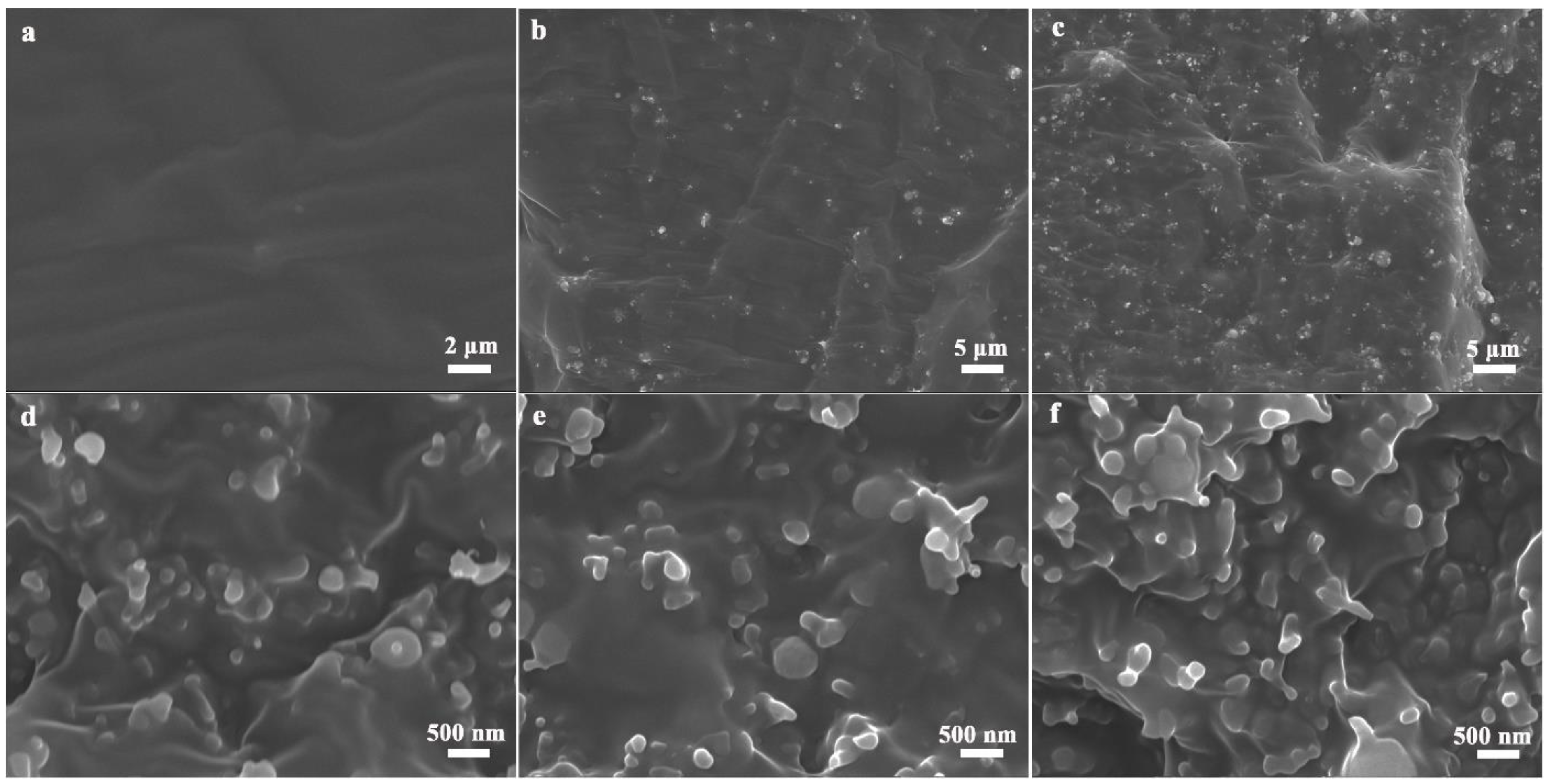
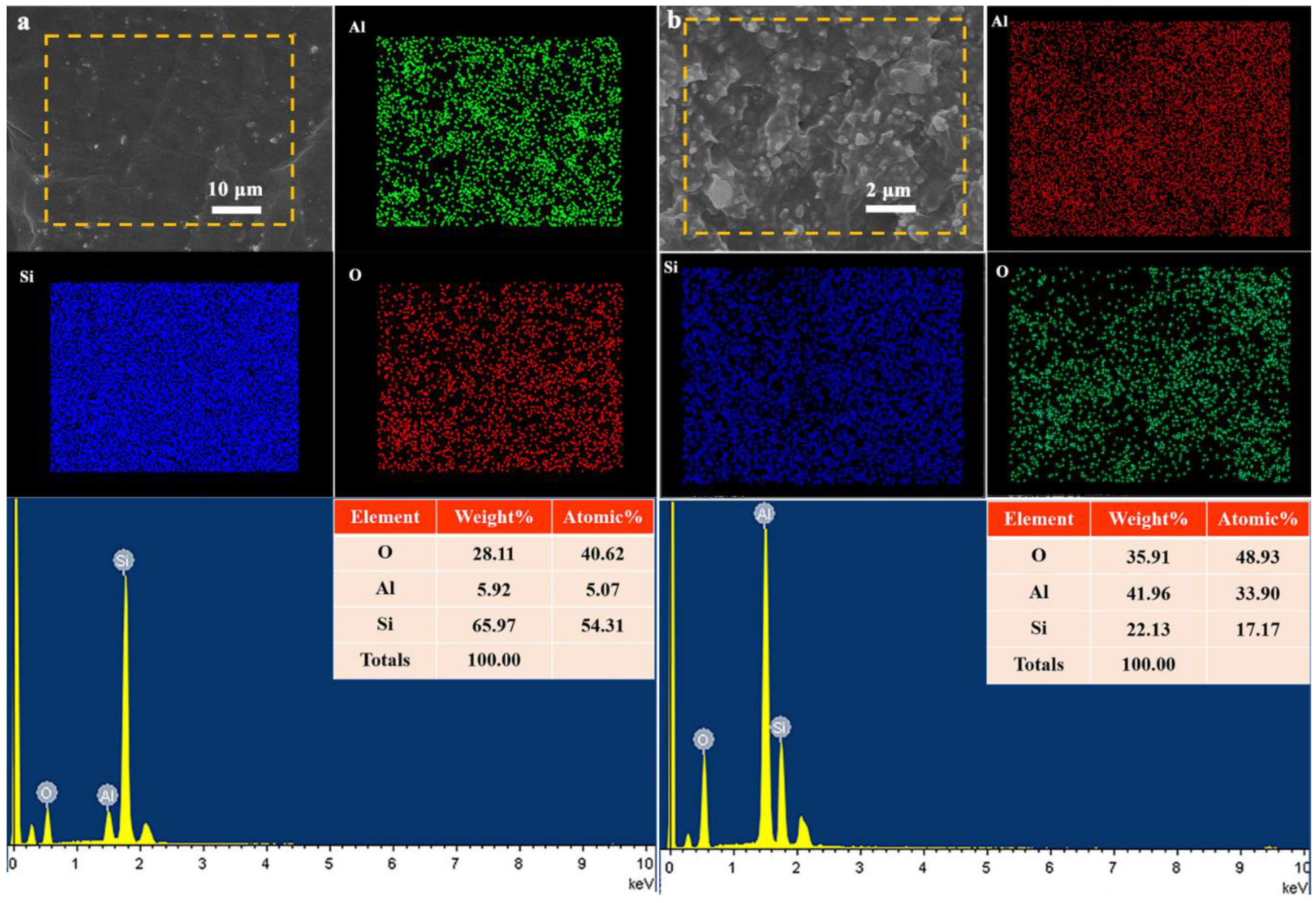
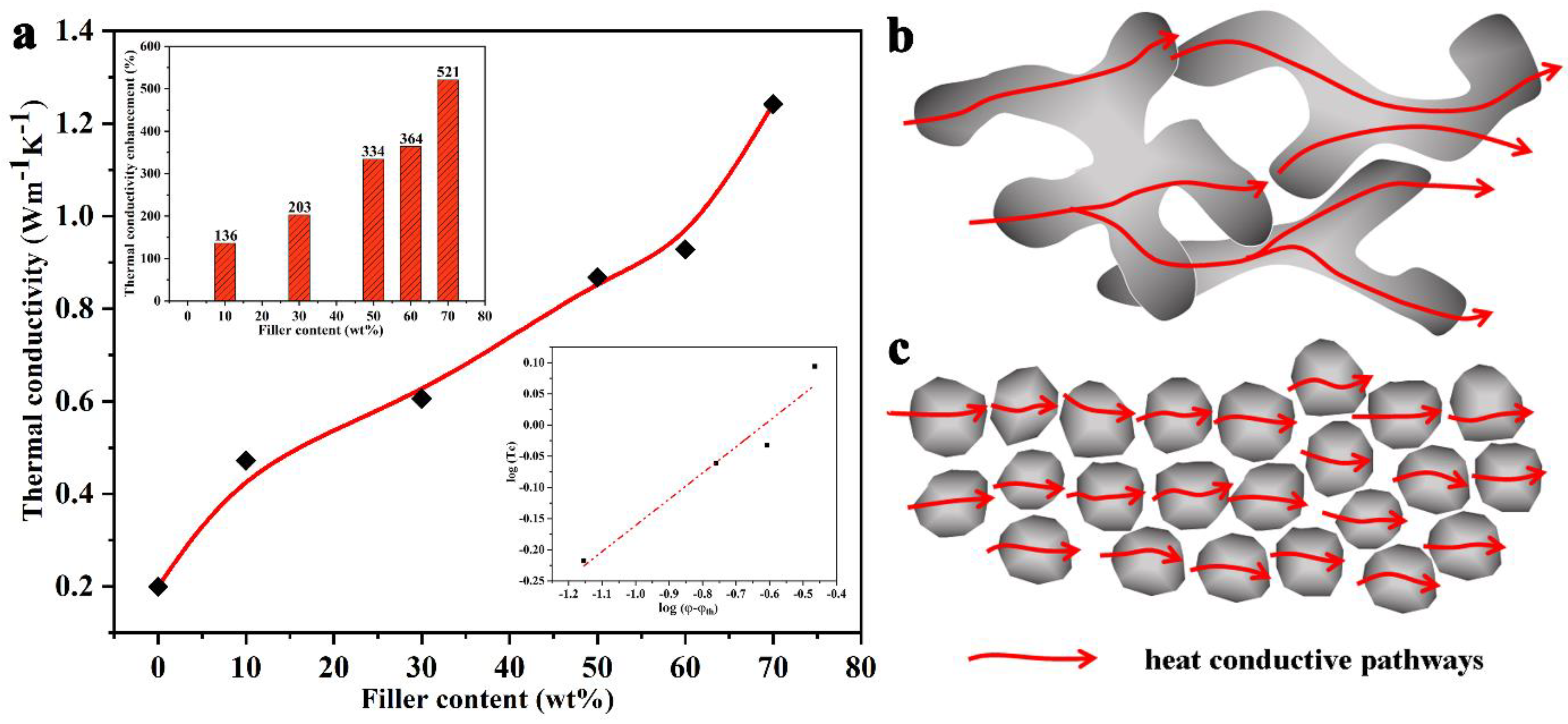
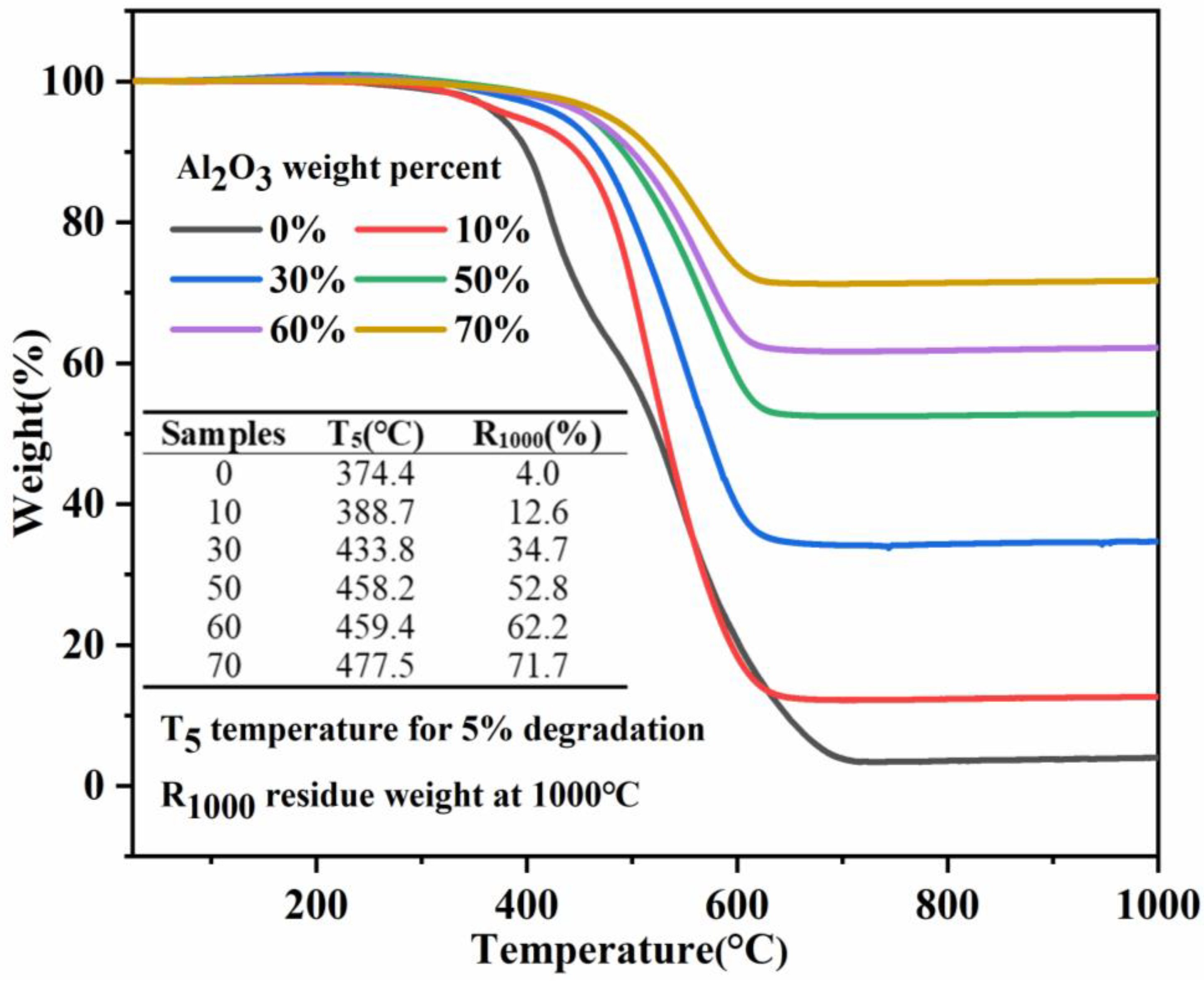

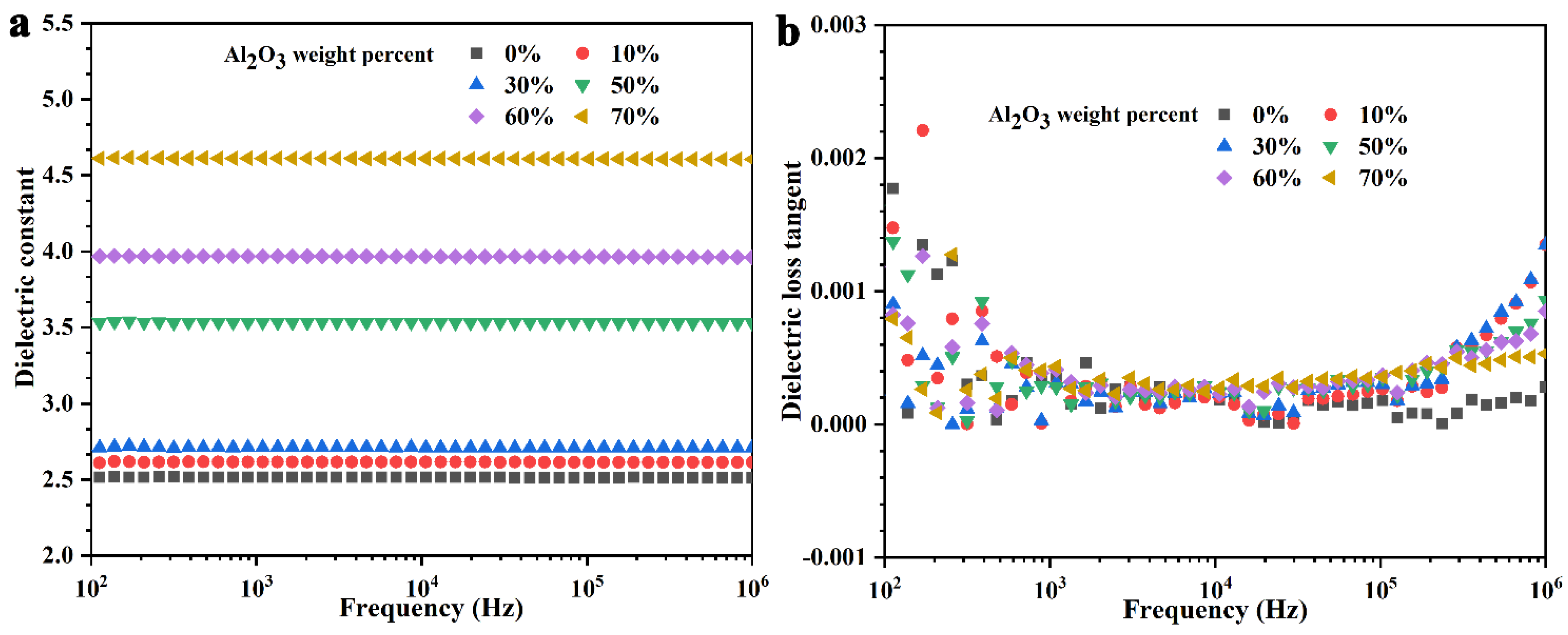
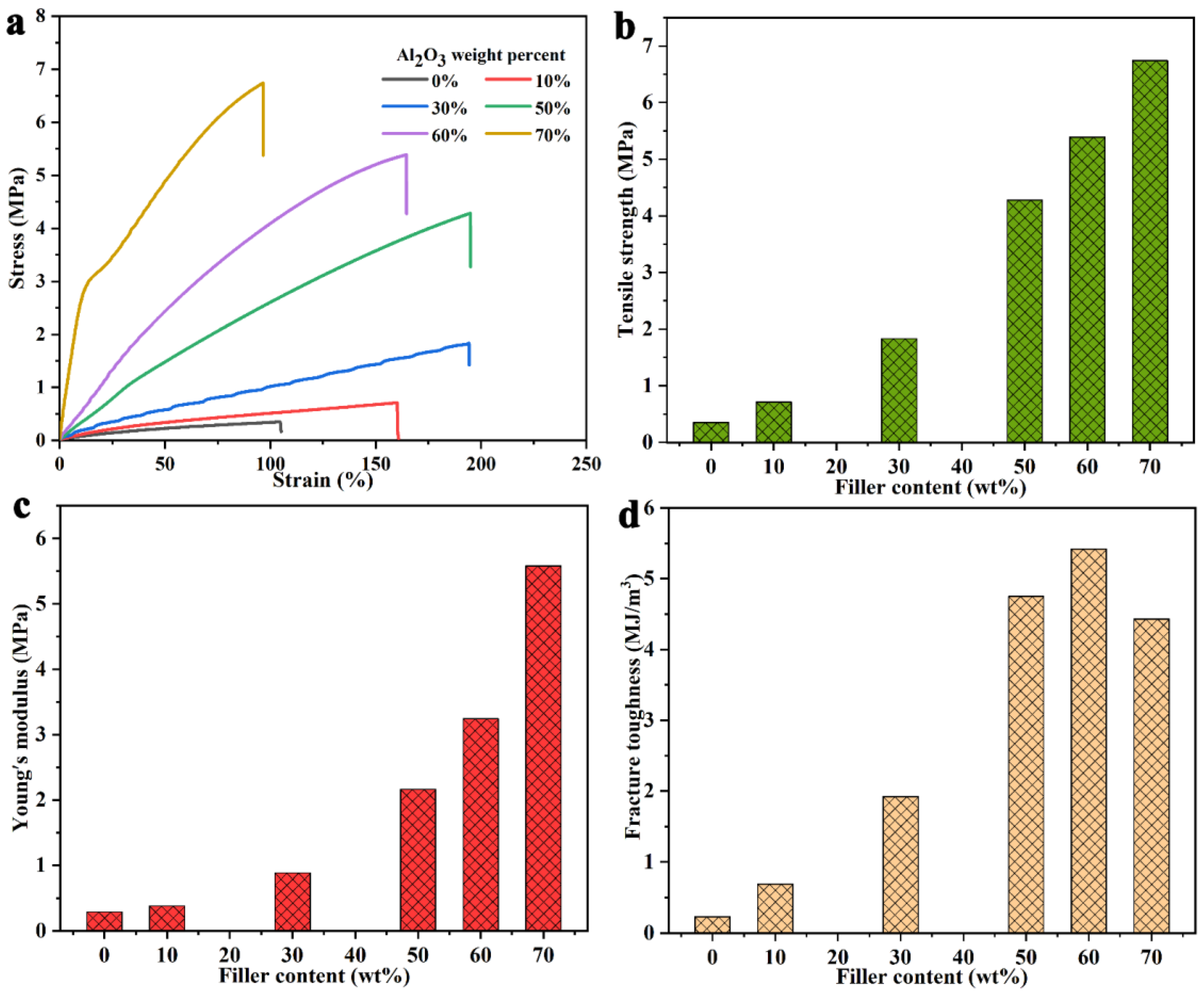
Publisher’s Note: MDPI stays neutral with regard to jurisdictional claims in published maps and institutional affiliations. |
© 2021 by the authors. Licensee MDPI, Basel, Switzerland. This article is an open access article distributed under the terms and conditions of the Creative Commons Attribution (CC BY) license (https://creativecommons.org/licenses/by/4.0/).
Share and Cite
Ouyang, Y.; Li, X.; Tian, H.; Bai, L.; Yuan, F. A Novel Branched Al2O3/Silicon Rubber Composite with Improved Thermal Conductivity and Excellent Electrical Insulation Performance. Nanomaterials 2021, 11, 2654. https://doi.org/10.3390/nano11102654
Ouyang Y, Li X, Tian H, Bai L, Yuan F. A Novel Branched Al2O3/Silicon Rubber Composite with Improved Thermal Conductivity and Excellent Electrical Insulation Performance. Nanomaterials. 2021; 11(10):2654. https://doi.org/10.3390/nano11102654
Chicago/Turabian StyleOuyang, Yuge, Xiaofei Li, Huafeng Tian, Liuyang Bai, and Fangli Yuan. 2021. "A Novel Branched Al2O3/Silicon Rubber Composite with Improved Thermal Conductivity and Excellent Electrical Insulation Performance" Nanomaterials 11, no. 10: 2654. https://doi.org/10.3390/nano11102654
APA StyleOuyang, Y., Li, X., Tian, H., Bai, L., & Yuan, F. (2021). A Novel Branched Al2O3/Silicon Rubber Composite with Improved Thermal Conductivity and Excellent Electrical Insulation Performance. Nanomaterials, 11(10), 2654. https://doi.org/10.3390/nano11102654




